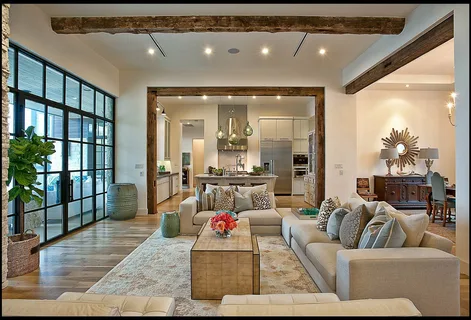
Interior design is both an art and a science—a creative process that involves transforming empty rooms into functional, aesthetically pleasing environments that meet the needs and desires of those who inhabit them. It’s about more than just selecting furniture and paint colors; it’s about understanding spatial relationships, harnessing the power of light and color, and creating atmospheres that evoke emotion and inspire creativity. In this exploration, we’ll delve into the fundamental principles of interior design and how they come together to shape the spaces we live, work, and play in.
Understanding Space and Functionality
Space is the canvas on which interior designing work their magic. It encompasses not only the physical dimensions of a room but also its purpose and functionality. Before any design decisions are made, it’s essential to understand how the space will be used and who will be using it.
For example, a living room may serve as a place for relaxation and entertainment, while a home office needs to be conducive to focus and productivity. By understanding the unique requirements of each space, designers can create layouts that optimize flow, functionality, and comfort.
The Role of Scale and Proportion by interior design
Scale and proportion are fundamental principles that govern the arrangement of elements within a space. Scale refers to the size of objects relative to the size of the room, while proportion relates to the relationship between different elements within the space.
Properly scaled furniture and accessories help establish a sense of balance and harmony within the room. Oversized furniture can overwhelm a small space, while undersized pieces can make aroom feel sparse and disjointed. By carefully selecting furnishings that complement the scale of the room, designers can create cohesive and visually pleasing interiors.
Proportion, on the other hand, involves the relationship between different elements within the space. For example, a large sectional sofa may be balanced by a pair of matching armchairs and a coffee table of similar scale. Creating a sense of proportion ensures that no single element dominates the room and that each piece contributes to a harmonious whole.
Harnessing the Power of Light and Color
Light and color are powerful tools in the interior designer’s arsenal, capable of transforming the mood and atmosphere of a space. Natural light, in particular, is highly prized for its ability to create a sense of openness and vitality within a room. See this: https://youtube.com/shorts/ayJxhsvgXHs
When designing with light, it’s essential to consider both the quantity and quality of light in the space. Maximizing natural light through strategically placed windows and skylights can help reduce the need for artificial lighting while creating a connection to the outdoors.
Color, meanwhile, has the power to evoke emotion, stimulate the senses, and define the character of a room. Warm hues like reds, oranges, and yellows can create a sense of intimacy and coziness, while cool tones such as blues and greens promote relaxation and serenity. By understanding the psychological effects of color, designers can create spaces that resonate with the needs and preferences of their clients.
Creating Visual Interest with Texture and Pattern
Texture and pattern add depth and dimension to a room, creating visual interest and tactile appeal. From smooth, glossy surfaces to rough, textured fabrics, incorporating a variety of textures creates richness and complexity within the space.
Patterns, whether bold and graphic or subtle and understated, can add personality and dynamism to a room. Mixing patterns and textures adds visual intrigue and prevents the space from feeling flat or monotonous. Read this: https://toastul.com/
The Importance of Balance and Harmony
Balance and harmony are essential principles of interior design, ensuring that all elements within the space work together harmoniously. Achieving balance involves distributing visual weight evenly throughout the room, whether through symmetrical arrangements or asymmetrical compositions.
Harmony, meanwhile, involves creating a sense of unity and coherence within the space. This can be achieved through repetition of color, pattern, and texture, as well as through the careful selection of furnishings and accessories that complement one another.
Conclusion
Interior design is a multifaceted discipline that encompasses art, science, and psychology. By understanding the fundamental principles of space, scale, light, color, texture, pattern, balance, and harmony, designers can create spaces that are not only beautiful but also functional, comfortable, and conducive to the needs and desires of those who inhabit them.
From residential interiors to commercial spaces, the principles of interior design apply across a wide range of contexts. By harnessing the power of design to shape environments that inspire, uplift, and enrich the lives of their occupants, interior designers have the opportunity to create spaces that truly enhance the human experience.



